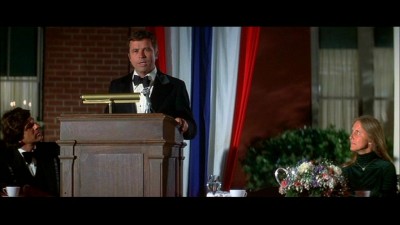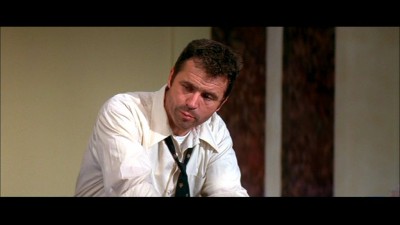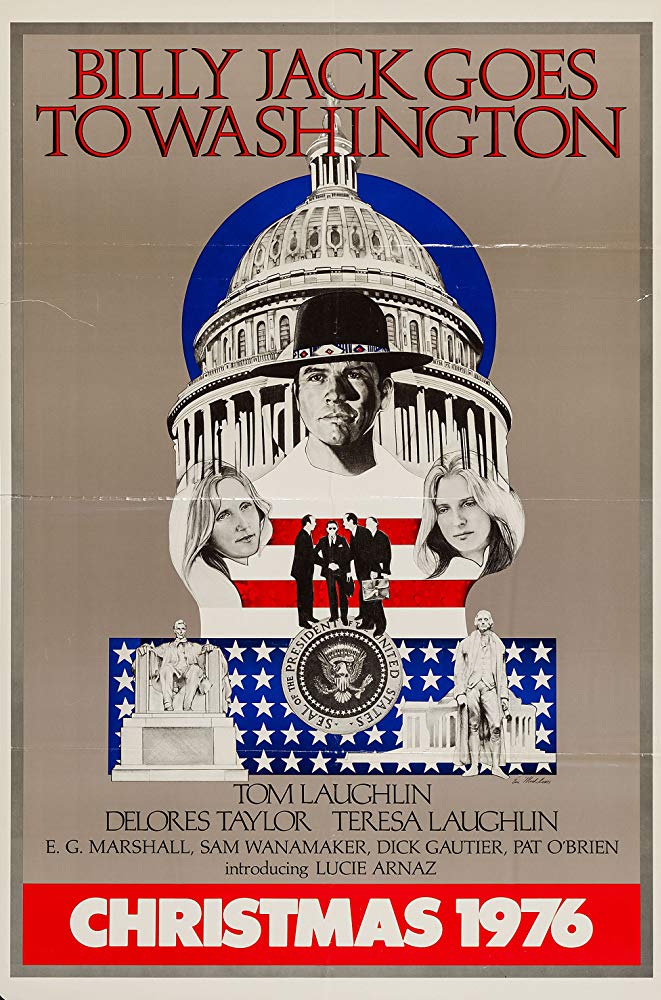It’s the end of the line for Billy Jack.
By Paul Mavis
Some years back, Shout! Factory through their Shout Select line released Billy Jack: The Complete Collection on Blu-ray (a DVD set was released earlier by Image Entertainment) including all 4 of Tom Laughlin’s pacifist whup-ass epics: The Born Losers, Billy Jack, The Trial of Billy Jack, and Billy Jack Goes to Washington. Let’s take a look at the fourth and final film, 1977’s Billy Jack Goes to Washington.
Click to order Billy Jack: The Complete Collection at Amazon.
Your purchase helps pay the bills at this website!
When Senator Sam Folley (Kent Smith) drops dead after illegally closing hearings concerning the building of nuclear power plants, aide Dan McArthur (John Lawlor) swipes the Senator’s sensitive file on all the nuclear goodies and high-tails it out of there, leaving fellow aide Saunders McArthur (Lucie Arnaz) behind to clean up the mess. Soon, the phones are ringing in Washington, and Folley’s fellow Senator, Joseph Paine (E. G. Marshall), calls up Governor Hubert Hopper (Richard Gautier) to see who can be placed in Folley’s stead so as not to gum-up the works of the top secret nuclear plant deal cooked up by Paine and his longtime political “boss,” magnate Bailey (Sam Wanamaker). Bailey and Paine want someone safe and controllable, but Governor Hopper somehow gets it into his head that pardoning Billy Jack (Tom Laughlin) and appointing him interim Senator would be a wise move politically, and before you know it…Billy Jack Goes to Washington.

Of course, once there and finally bedecked in all his Billy Jack finery (his one concession to decorum? He doesn’t walk around the Senate building barefoot), Billy finds out how corrupt Washington truly is, and wonders who the hell he can punch to set things right. Unfortunately, such actions would result in immediate expulsion, so Billy has to settle on the CIA hit squad who are sent to take out one of Billy’s aides. Evidently, Billy’s muck-racking team is unearthing nasty truths about government—and the corruption surrounding the nuclear-power industry—that are making some higher ups very nervous. Soon, Dan is found belly-up with a shiv stuck in him, and Billy Jack is next as he discovers the secret behind Paine’s dirty deals with Bailey, bringing Washington to a halt as he filibusters the Senate.

Legendary among high-profile flops, Billy Jack Goes to Washington is the easiest Billy Jack movie to deal with…because it’s barely a Billy Jack movie at all. Ostensibly a remake of Capra’s Mr. Smith Goes to Washington, the Laughlins throw in some trendy updates (such as the nuclear power angle, along with discussions about how bills are made and broken by Washington corruption), but it’s close in spirit to the original story…if miles and miles away from the technical and aesthetic proficiency of that first film.
RELATED | More 1970s film reviews
The Laughlins, in their commentaries, state the film was never officially released, although I’ve read where it had some premieres (although curiously, in an old reference book I have for movies from Consumer Reports, they list feedback data and ratings for the movie from readers who claim to have seen the film). According to the Laughlins, Billy Jack Goes to Washington was scuttled by the powers-that-be in Washington, who warned distributors away from the movie out of fear its message would jeopardize their covert set-up with the nuclear power industry.

Uh…yeah. What can be said with complete and utter conviction, is that had Billy Jack Goes to Washington been released to theatres, there would have been a whole lot of disappointed Billy Jack fans out there. Not that there’s a whole lot of “Billy Jack-ness” in the first three movies, anyway, but by the time Billy Jack Goes to Washington rolls around, it’s hard to see where Laughlin was trying to go with this character.

Forget the fact that the central premise of the movie makes absolutely no sense. What corrupt politician in their right mind would appoint convicted troublemaker Billy Jack—a known and willing crusader against corrupt government—to the role of State senator with the idea that he could be safely handled? If you watch the movie, keeping the associations with the previous Billy Jacks in mind, you can see what a ludicrous idea this is in which to hang on a movie. And if you don’t buy the central plot device that gets Billy Jack to Washington, it’s a tough slog through the movie-of-the-week dialogue and the flat-as-a-pancake direction (and when you see four principal editors credited to a movie…look out: that’s the kiss of death).

Making the Laughlins’ limited filmmaking skills even more pronounced this go-around is the sight of a couple of truly great, professional actors showing up here—a real rarity with the Billy Jack series where non-professionals can dominate. E.G. Marshall and Sam Wannamaker have a couple of good scenes together where they dominate the banal dialogue, giving their moments an added level of believability that certainly isn’t warranted by the material (it’s great to see legendary Pat O’Brien, as well, in one of his last roles—pity it wasn’t larger).
But Delores Taylor—who was probably the best thing in Billy Jack (which ain’t saying much…)—is cut back severely here, while Lucie Arnez (yikes) pops in and out of the movie with ineffectual regularity (her “big” scene where she screeches at Billy about Washington corruption, is quite simply, an embarrassment for all concerned. And that includes the entire run of Here’s Lucy). Tom Laughlin fails to find anything new to do with the Billy character, limited as he is by the movie’s setting, which isn’t exactly conducive to Billy Jack busting some heads (one fight scene is included, but it’s cut off fairly quickly).

Laughlin, never the most expressive actor, looks quite bored, actually, in most of his scenes, as if he’s preoccupied going over in his head all the overages his production company created when he built a ridiculously expensive recreation of the Senate chambers . Eventually, Billy Jack Goes to Washington gives up trying to be a Billy Jack movie and settles down into a rather conventional remake—a remake whose sole achievement is making the viewer long to watch the original inspiration (reportedly, Jimmy Stewart was asked to do a cameo…but he pulled his old, “I can’t hear you,” fake-out and wisely dodged this bullet).
With the disastrous failure of Billy Jack Goes to Washington (various reports indicate the Laughlins personally lost over $20 million on this!), the Laughlins’ movie empire came to an end. An aborted attempt to film a fifth Billy Jack movie was attempted in 1985, but a severe accident suffered by Tom Laughlin ended that project. With the remaining audience that even remembers Billy Jack getting older by the day, I doubt we’ll see a reboot anytime soon. Thank god.

Our Billy Jack reviews:
- The Born Losers
- Billy Jack
- The Trial of Billy Jack
- Billy Jack Goes to Washington
PAUL MAVIS IS AN INTERNATIONALLY PUBLISHED MOVIE AND TELEVISION HISTORIAN, A MEMBER OF THE ONLINE FILM CRITICS SOCIETY, AND THE AUTHOR OF THE ESPIONAGE FILMOGRAPHY. Click to order.


[…] Tom Laughlin’s pacifist whup-ass epics: The Born Losers, Billy Jack, The Trial of Billy Jack, and Billy Jack Goes to Washington. Let’s take a look at the third film, 1974’s The Trial of Billy […]
LikeLike
[…] Tom Laughlin’s pacifist whup-ass epics: The Born Losers, Billy Jack, The Trial of Billy Jack, and Billy Jack Goes to Washington (later, Shout! Factory through their Shout Select line released Billy Jack: The Complete Collection […]
LikeLike
Billy Jack goes ape shit? The original little Greta, as in ‘How Dare you.’ I would not let Billy Jack walk my dog.
LikeLiked by 2 people
[…] Billy Jack Goes to Washington […]
LikeLike